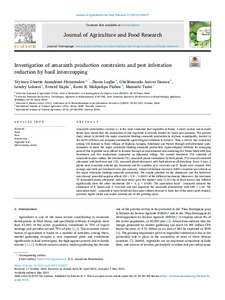| dc.contributor.author | Azandémè-Hounmalon, G.Y. |
| dc.contributor.author | Logbo, J. |
| dc.contributor.author | Dassou, A.G. |
| dc.contributor.author | Lokossi, L. |
| dc.contributor.author | Akpla, E. |
| dc.contributor.author | Fiaboe, K. |
| dc.contributor.author | Tamo, M. |
| dc.date.accessioned | 2023-05-25T10:30:20Z |
| dc.date.available | 2023-05-25T10:30:20Z |
| dc.date.issued | 2023-06 |
| dc.identifier.citation | Azandémè-Hounmalon, G.Y., Logbo, J., Dassou, A.G., Lokossi, L., Akpla, E., Fiaboe, K. & Tamo, M. (2023). Investigation of amaranth production constraints and pest infestation reduction by basil intercropping. Journal of Agriculture and Food Research, 12: 100627, 1-8. |
| dc.identifier.issn | 2666-1543 |
| dc.identifier.uri | https://hdl.handle.net/20.500.12478/8180 |
| dc.description.abstract | Amaranth (Amaranthus cruentus L.) is the most consumed leaf vegetable in Benin. A study carried out in south Benin have shown that the production of this vegetable is severely limited by insect pest pressure. The present study aimed to identify the major constraint limiting amaranth production in Ségbana municipality, located in the north of Benin and proposed sustainable agroecological solutions to farmers. Thus, a survey was conducted among 150 farmers in three villages of Ségbana (Lougou, Sokotindji and Piami) through well-structured questionnaires to know the major constraint limiting amaranth production. Agroecological methods for managing pests of this vegetable were offered to farmers through an experimental trial consisting of a Fisher block with four treatments and five replications conducted in Sokoundji village. The control treatment (To) consisted of amaranth in pure culture; the treatment (T1), amaranth plants surrounded by basil plants; (T2) rows of amaranth alternated with basil rows and (T3), amaranth plants alternated with basil plants in all directions. Every 5 days, 5 plants were randomly selected per treatment and the numbers of S. recurvalis and P. basalis were counted. Pest damage and yield per treatment were also assessed. Almost all farmers surveyed (100%) reported pest attacks as the major constraint limiting amaranth production. The results obtained on the abundance and the herbivory rate showed powerful negative effects (Df = 3; P < 0.0001) of the different treatments. Moreover, the treatment T2 (amaranth plants alternated with basil rows) gave the highest yield (1.25 t/ha of fresh leaves) and differed significantly from the other treatments (Df = 3; p = 0.039). The association basil – amaranth reduced the abundance of P. basalis and S. recurvalis and also improved the amaranth productivity with LER = 1.16. The association basil – amaranth is more beneficial than pure cultures because it hosts less of the insect pests studied, provides higher yields and makes rational use of the growing space. |
| dc.description.sponsorship | Universite Nationale d’Agriculture, Benin |
| dc.description.sponsorship | International Institute of Tropical Agriculture |
| dc.format.extent | 1-8 |
| dc.language.iso | en |
| dc.subject | Yields |
| dc.subject | Pests |
| dc.subject | Productivity |
| dc.subject | Vegetables |
| dc.subject | Intercropping |
| dc.subject | Agroecology |
| dc.subject | Amaranth Leaves |
| dc.title | Investigation of amaranth production constraints and pest infestation reduction by basil intercropping |
| dc.type | Journal Article |
| cg.contributor.crp | Grain Legumes |
| cg.contributor.crp | Roots, Tubers and Bananas |
| cg.contributor.affiliation | Universite Nationale d’Agriculture, Benin |
| cg.contributor.affiliation | Universite Nationale des Sciences, Technologies, Ingenierie et Mathematiques, Benin |
| cg.contributor.affiliation | Universite d' Abomey-Calavi |
| cg.contributor.affiliation | International Institute of Tropical Agriculture |
| cg.coverage.region | Africa |
| cg.coverage.region | West Africa |
| cg.coverage.country | Benin (Dahomey) |
| cg.coverage.hub | Central Africa Hub |
| cg.coverage.hub | Headquarters and Western Africa Hub |
| cg.researchtheme | Natural Resource Management |
| cg.researchtheme | Plant Production and Health |
| cg.isijournal | ISI Journal |
| cg.authorship.types | CGIAR and developing country institute |
| cg.iitasubject | Agronomy |
| cg.iitasubject | Crop Systems |
| cg.iitasubject | Food Security |
| cg.iitasubject | Pests of Plants |
| cg.iitasubject | Plant Breeding |
| cg.iitasubject | Plant Health |
| cg.iitasubject | Plant Production |
| cg.journal | Journal of Agriculture and Food Research |
| cg.notes | Open Access Journal; Published online: 06 May 2023 |
| cg.accessibilitystatus | Open Access |
| cg.reviewstatus | Peer Review |
| cg.usagerightslicense | Creative Commons Attribution 4.0 (CC BY 0.0) |
| cg.targetaudience | Scientists |
| cg.identifier.doi | https://doi.org/10.1016/j.jafr.2023.100627 |
| cg.iitaauthor.identifier | Komi Fiaboe: 0000-0001-5113-2159 |
| cg.futureupdate.required | No |
| cg.identifier.issue | 00627 |
| cg.identifier.volume | 12 |

